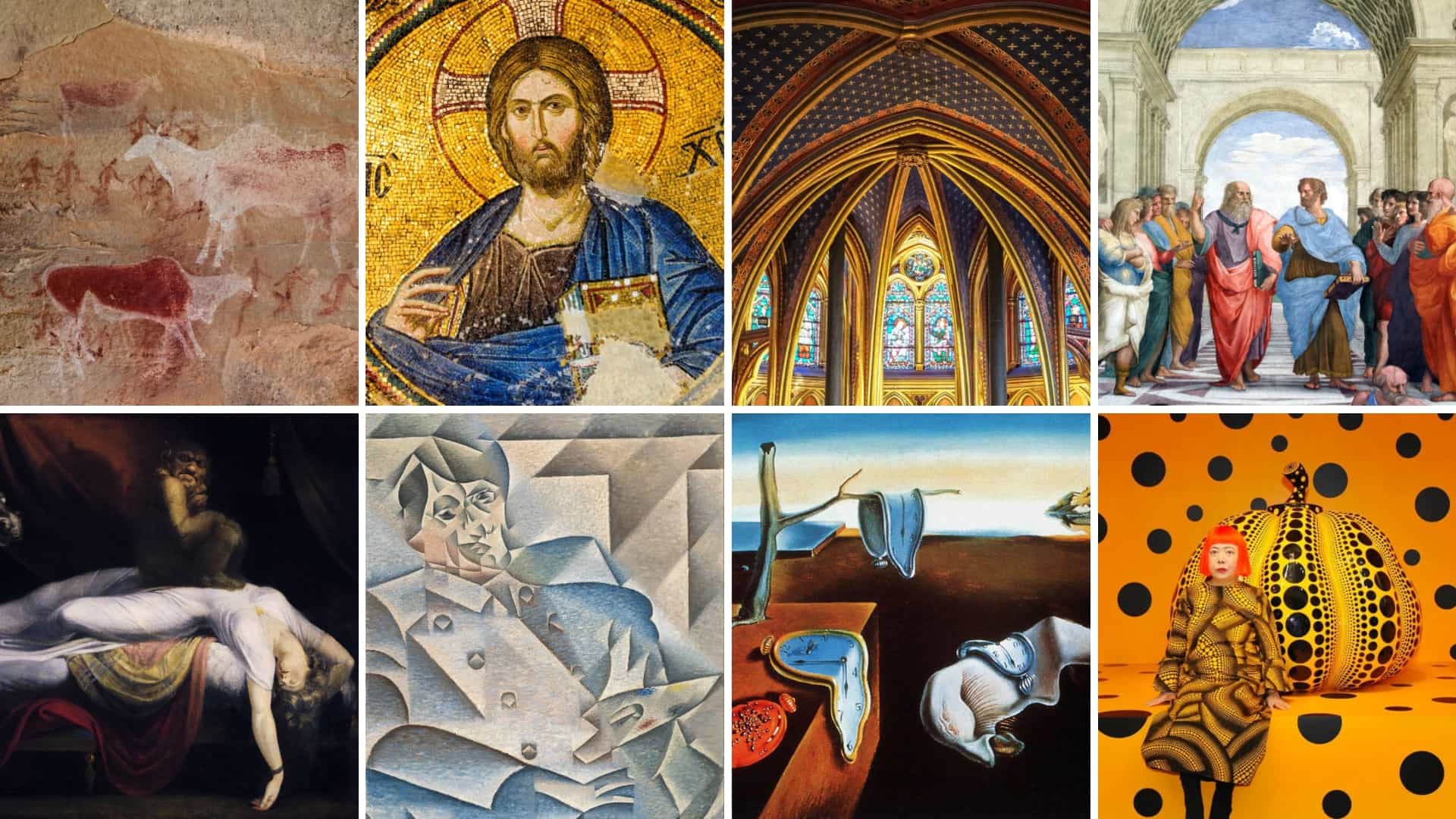The history of art is overwhelmingly dense. Scholars, artists, and historians have spent lifetimes studying, discovering, and preserving art throughout history. In this article, we’re going to narrow out focus on one facet of the art history timeline — art movements in the Western world.
And while there are undoubtedly more art movements left off this list, we’ll be diving into some of the most influential movements in art history. From Prehistoric art all the way to Contemporary art, let’s take a look at how art, artists, and the approach to creating art has evolved over time.
Art Movements Timeline
A quick guide to art history chronology
As with many areas of human history, it is impossible to delineate the different art periods with precision. Some eras last for a few thousand years while others span less than ten. Art is a continuous process of exploration, where more recent periods grow out of existing ones.

Art History Timeline
What follows is a general survey of the main art history periods. There is, of course, a much deeper and more complicated history that our individual articles cover in further detail. For more, check out our index of art styles covering more specific and noteworthy movements.
Beginning of the Art History Timeline
Prehistoric Art (~40,000 — 4,000 B.C.)

Prehistoric Art history Timeline • The Lascaux Cave Paintings
Before the genesis of written language, prehistoric cultures utilized artistic means of communication and documentation of the world around them. Artistic works such as cave paintings, rock carvings, stone arrangements, and engraved pictorial imagery date back to the Paleolithic era and Old Stone Age.
These Prehistoric artworks often depicted cultural events such as rituals or depictions of the environment such as animals and landscapes. Natural materials such as stone were common in prehistoric sculptures and engravings. Pigments from natural materials were often used to create illustrations in cave paintings and the Paleolithic cave paintings in Lascaux in France.
Ancient Art History Periods
Ancient Art: (30,000 B.C. — A.D. 400)
How ancient art influenced modern art • Felipe Galindo
Ancient Art initially occurred parallel to much of Prehistoric art. Ancient art, however, was a product of civilizations that were advancing at a faster pace such as in Mesopotamia, Greece, Egypt, and Mesoamerica. With the creation of written language in much of these civilizations, religions, social structures, and storytelling became more prevalent.
Human beings utilized artistic methods to communicate and express these concepts. The influence of these artworks on later artists cannot be underscored. From Renaissance artists to even Cubist artists, Ancient artwork has been a source of inspiration for centuries to come.
Art Movements Timeline
Medieval (A.D. 500 — A.D. 1400)
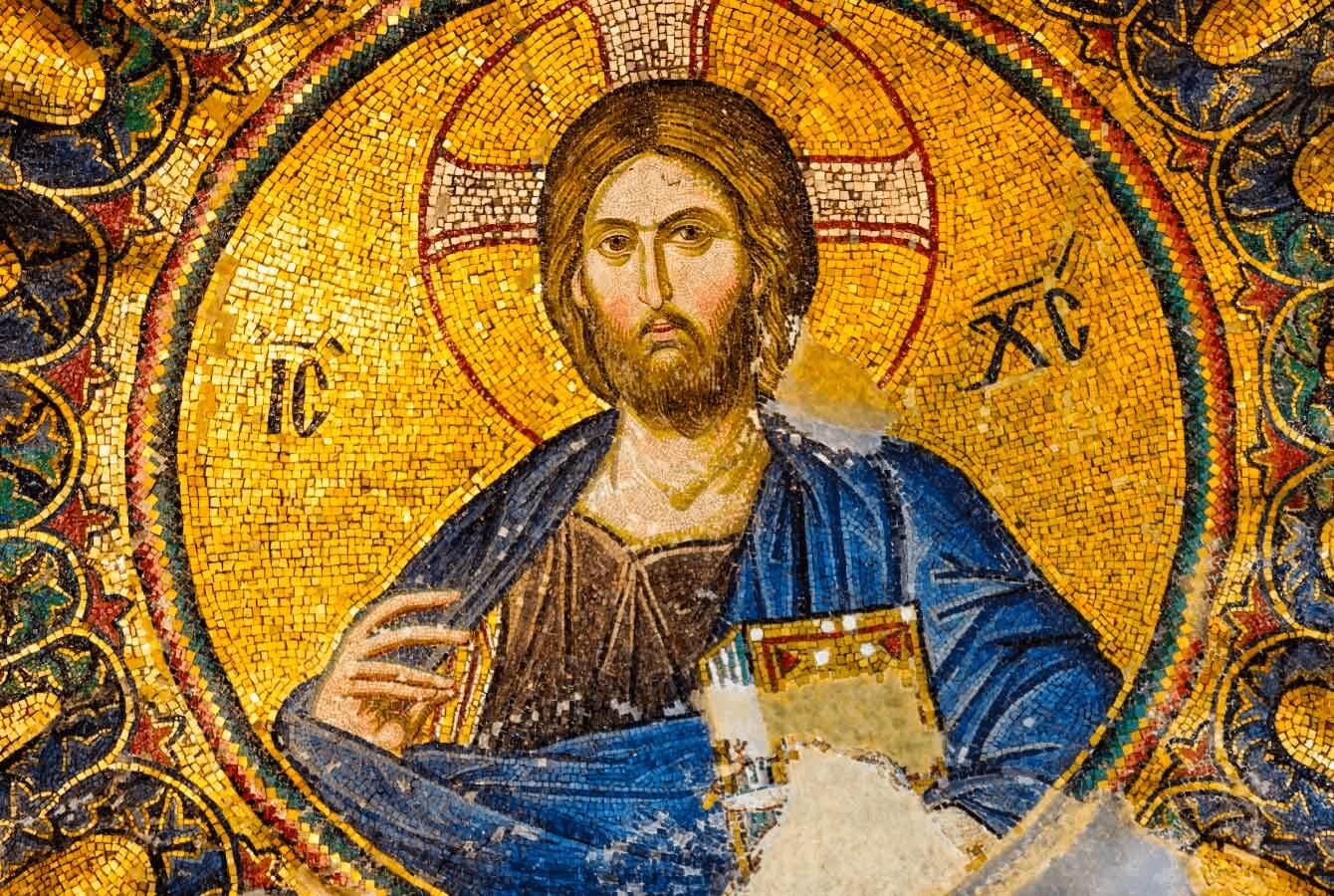
Jesus Christ Mosaic in Istanbul, Turkey
After the fall of the Roman Empire, economic strife led to what is now known as The Middle Ages. During this time, art focused predominantly around the hardship that those victims of the Roman Empire fallout endured. Simultaneously, the early Christian Church sought the use of valuable materials to form artworks that conveyed religious meaning. Medieval art is a culmination of these two historical events occurring in parallel.
Art History Eras
The Gothic Era (1100s — 1500s)
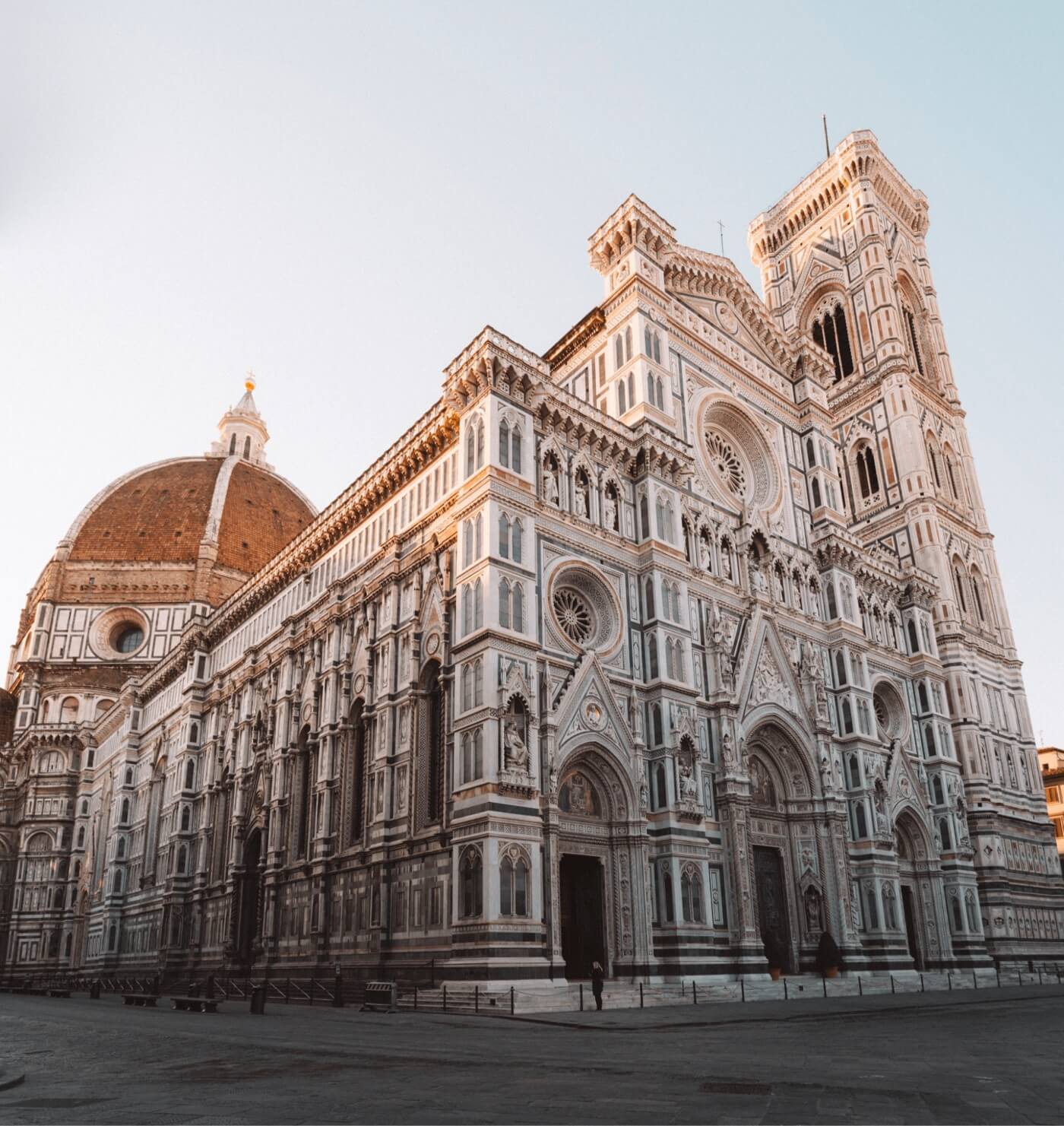
Florence Cathedral
Gothic art is a style of painting, architecture, and sculpture that began in Paris the middle of the 12th century and showed up throughout Europe all the way into the 1500s. The architectural style’s definitive feature is the pointed arch, while the definitive feature of Gothic painting and sculpture is naturalism. Some famous Gothic artists include Giotto, Konrad Witz, and Duccio di Buoninsegna.
Important Art History Periods
Renaissance (1300s — 1600s)
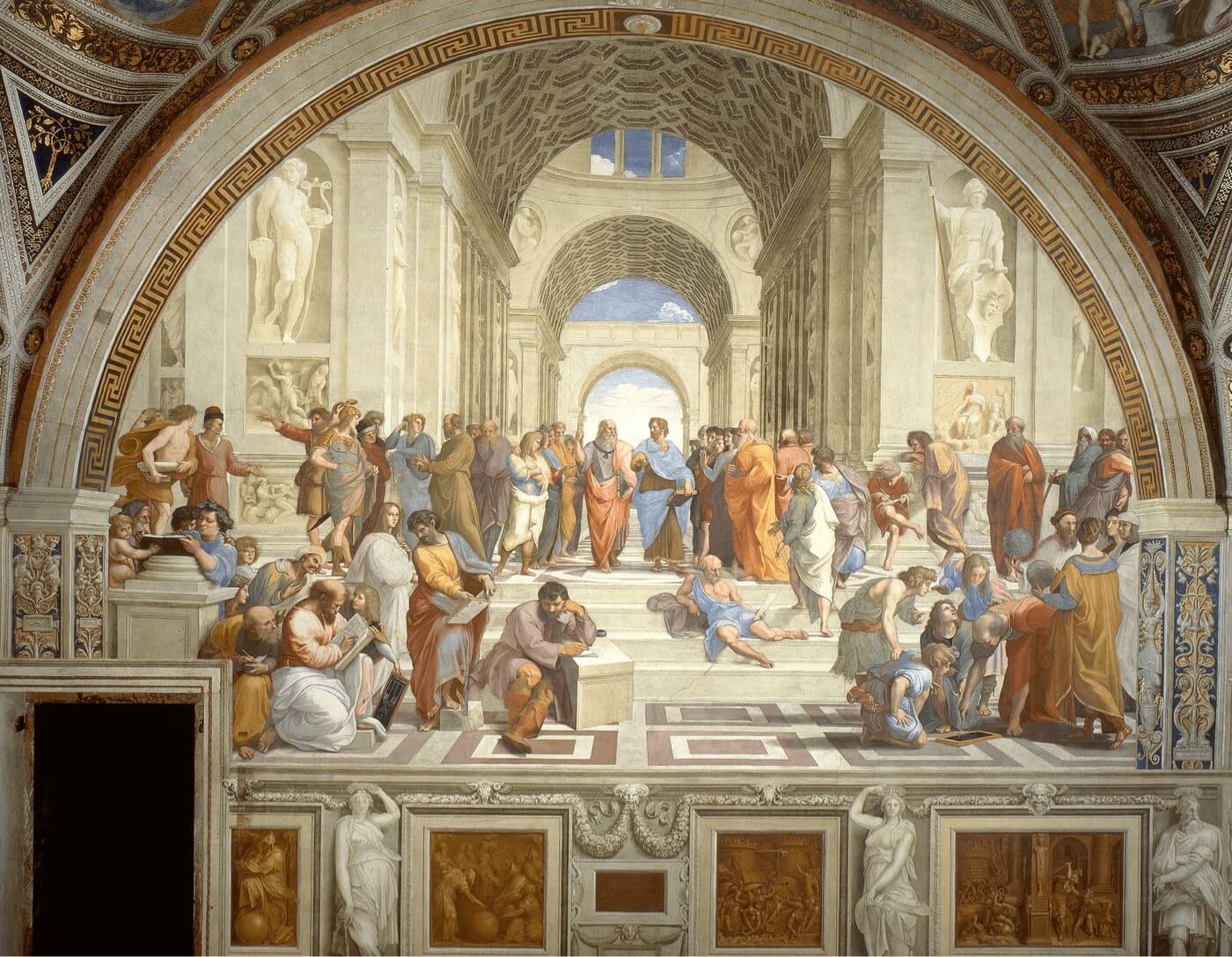
The School of Athens by Raphael
Over the course of roughly 300 years, artists throughout Europe reconnected to the concepts, styles, and subjects of ancient Rome and ancient Greece. It is a cornerstone of Western culture and history, let alone art.
During the Renaissance, art in all its forms was looked at as a means to better society as a whole.
Philosophy and art went hand in hand according to the vision of Renaissance titans such as Lorenzo de Medici who was a primary patron of iconic Renaissance artists such as Da Vinci, Botticelli, and Michelangelo.
At the heart of the Renaissance was a philosophy of using the humanities to better the lives of individuals rather than as a means of outward status.
What was produced during the Renaissance holds so much prestige today not only because of the beauty in the works’ physical form, but the intent behind these works from various visionaries.
Timeline of Art Styles
Baroque (1600 — 1750)
Caravaggio: Master Of Light
Stylistically, Baroque artists were diverse and lacked singular distinction. What is common in Baroque art, however, is thematic representation of grandeur and human divinity. Baroque art favored human subjects such as royalty or religious leaders portrayed in divine ways. Some of the most notable Baroque artists like Caravaggio and Rembrandt utilized deep contrast of shadow and light (also known as chiaroscuro) to create striking drama.
Art History Timeline in Order
Neoclassicism (1750 — 1850)
The Death of Socrates: How To Read A Painting
During the early to mid 1700s, archaeological discoveries of ancient Greece and Rome sparked a lure toward artworks of the past. Influenced deeply by Classicism, Neoclassicism was the resurgence of the classical style of Roman and Greek art in the late-18th to early-19th by artists around the globe.
Understanding the Art Movements Timeline
Romanticism (1780 — 1850)
HISTORY OF IDEAS • Romanticism
In stark contrast to the rather unemotional Neoclassical artworks, Romanticism found value in passions and deeply emotional subject matter within art. At its core is not a style, but a way of thinking. One that values sensitivity and intense emotion within a fulfilling life.
Artists such as Francisco Goya, Henry Fuseli, and William Blake discarded the neat order and rationality of Neoclassicism. Rather, their artistic curiosities led them to sensation and feeling. This is why many artworks of Romanticism have drawn inspiration from nature and internal psychology. The influence of Romanticism on modern arts such as music and cinema that thrive on human emotion cannot be understated.
History of Art Timeline
Realism (1848 — 1900)
The Case for Realism
Up until the emergence of what came to be known as Realism, art primarily focused on the subjects of mythology, history, religion, and emotionally charged drama. The mundanity of everyday life was oversought. That is until the movement of Realism.
Artists like Gustave Courbet sought to depict the everyday scenes of normal people. These subjects were not commissioned or dictated by royalty or institution, but rather inspired by the real world as it presented itself.
Art History Simplified
Impressionism (1865 — 1885)

One of the paintings from the Water Lilies Series by Claude Monet
While Impressionism borrows from Realism as far as focusing on everyday subject matter, it distinguishes itself in style. Impressionism focuses on initial sensations and impressions an artist has of a scene and basing their work off of this rather than what reality presents.
Because of this, Impressionist work often displays quick brush strokes with an almost sketch-like style. Subjects and environments are less defined by parameters, but rather by color and energetic brush strokes.
As an artist almost synonymous with the Impressionist art movement, Claude Monet talks of his work saying, “Now I really feel the landscape. I can be bold and include every tone of pink and blue: it's enchanting, it's delicious.”
Van Gogh Art Movements Timelines
Post-Impressionism (1885 — 1910)

Vincent van Gogh: A Wheatfield, with Cypresses (1889)
Toward the late 1800s, artists independently began desiring more self expression within their work. A desire to express inward emotion and individual perception rather than what is simply presented to them by the outside world.
The artists and work that emerged during this time were a product of what is now known as Post-Impressionism. Iconic artists such as Vincent van Gogh, Paul Gauguin, and Georges Seurat were some of the more prolific artists to come out of the Post-Impression movement.
A Guide to the Art History Timeline
Expressionism (1905 — 1920)

Franz Marc, Blue Horses, 1911
Expressionism is an art type, style, and movement that emphasizes subjective feeling in its works. This contrasts with other painting styles of the late 19th century that put an emphasis on objectivity and realism. Expressionism art, therefore, was both a rejection and reaction of more realist styles. It was also a reaction of the changing world these early 20th century artists were witnessing.
Pablo Picasso in Art Periods Timeline
Cubism (1907 — 1914)
How To Understand A Picasso
Cubism is an influential art style defined by its revolutionary method of depicting three-dimensional reality through geometrical shapes on a two-dimensional canvas.
The term “Cubism” was coined by Louis Vauxcelles, a 20th century art critic. When writing a critique of artist Georges Braque’s landscape work, Vauxcelles identified geometric shapes and referred to them as “cubes.”
Cubist artists depict a subject by utilizing geometrical shapes and forms from varying perspectives of the subject. In practice, form, and observation, cubism is a means of discovering the true essence of a subject rather than a surface level perspective.
Swiss Art History Chronology
Dadaism (1912 — 1923)

Artist Raoul Hausmann's c. 1920 assemblage, Mechanical Head (The Spirit of Our Age)
Dadaism is an art movement that emerged in 1916 in Zurich, Switzerland, and lasted until the mid 1920s. It veered from nearly every norm in the art world at the time and for this reason became attached to avante-garde art. Pure Dada rebuffs reason, logic, and rationality in favor of chance. The movement is explicitly political, representing extreme leftist views, primarily anarchism.
German Art Movements Timeline
Bauhaus (1920 — 1925)

Bauhaus Exhibition Poster (1923)
The Bauhaus, named after a German expression meaning “house of construction,” is a German artistic movement which lasted from 1919-1933. It was founded in Weimar, Germany by German architect Walter Gropius.
Its goal was to merge all artistic mediums into one unified approach, that of combining an individual’s artistry with mass production and function. Bauhaus design is often abstract, angular, and geometric, with little ornamentation.
Salvador Dalí Art History Timeline
Surrealism (1917 — 1950)

Salvador Dalí: The Persistence of Memory
Surrealism has given artists free reign over their collective subconscious. The end result has been some of the most daring and provocative works the world has ever seen.
Surrealism is an art movement that was founded by Andre Breton in 1924, and outlined in his book The Surrealist Manifesto. Surrealism as a technique relies on the juxtaposition of symbols, images, or actions to create a world outside of reality, a super-reality. Some of the most iconic Surrealist artists to emerge from the movement were Salvador Dalí, Andre Breton and Max Ernst.
Important Art Movements Timeline Periods
Abstract Expressionism (1940 — 1950s)
The Art Assignment • Abstraction
Abstract Expressionism is an artistic movement that emerged in the 1940s and 1950s that focuses on a shared curiosity in the utilization of abstraction as a means to express and/or elicit emotion through artistic works.
In the post-World War II era, American painters primarily based in New York, sometimes referred to as the New York School, began using various techniques and demonstrating diverse styles to express their emotions and attitudes in a completely abstracted way.
One of the more influential art movements on Abstract Expressionism was in fact Surrealism. Abstract Expressionists pulled from the Surrealists the idea that art is born out of the subconscious mind in a spontaneous manner.
Andy Warhol Art Periods Timeline
Pop Art (1950s — 1960s)

Drowning Girl (1962) • Roy Lichtenstein
In a stark turn from the work of Abstract Expressionism, artists from the U.S. and England began creating graphically styled illustrations full of bright colors often with underlying political commentary.
This evolved into the Pop Art movement. While many pop artists used the medium as a social critique, some found that it was ironically evolving into an endorsement of the very systems it is “critiquing.”
Some subjects like capitalism and war were at the core of famous Pop artists like Andy Warhol. Warhol when talking on the idea of Pop art has reaffirmed this mentality saying, “An artist is someone who produces things that people don’t need to have but that he – for some reason – thinks it would be a good idea to give them.”
Art Movements Timeline
Minimalism (1960s — 1970s)

Red Circle on Black, 1965 • Jiro Yoshihara
Minimalism emerged in the mid-twentieth century art movement largely as a response to both Pop art and Abstract Expressionism that came before it. It is characterized by its simplicity in concept and design.
Minimalists believed simplicity was to strip away any forced meaning or expression, a belief that very much contrasts that of the Abstract Expressionists. For minimalists, Simplicity in art meant creating art to be its own identity, not what we impress upon it.
Art History Timeline
Conceptual Art (1960s — 1970s)
The Case for Conceptual Art
Conceptual art is a form of art in which the concept is paramount to the visual or sensory components of the finished artwork. This type of art emphasizes the importance of an idea or concept over technique and aesthetic, largely used to express the abstract.
It emerged as a movement in the early 1960s reaching into the mid-1970s. Conceptual art can look or be nearly anything the artist decides. Unlike other forms of art, it is not defined by physical forms, but rather the foundation of a concept that serves as the engine of creating art.
Artistic Movements in Chronological Order
Contemporary Art (1970s — Present)
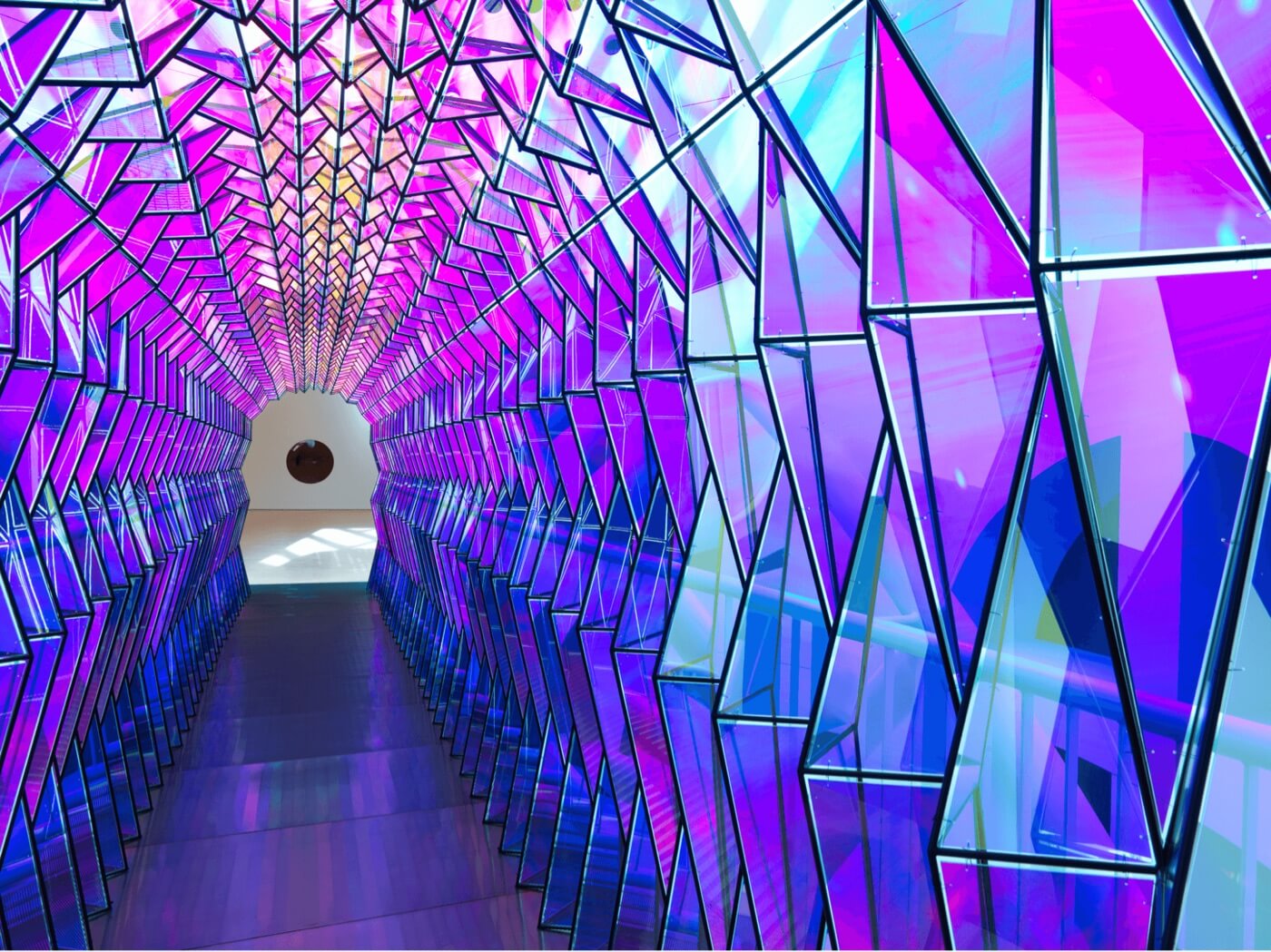
One-Way Colour Tunnel by Olafur Eliasson (2007)
To put it simply, contemporary art is art that’s made in the current era which is usually cited as 1970 to present day. Not to be confused with Modern Art which is defined by style and concept, contemporary art is defined by the time period in which a work of art was created. Because of this, examples of contemporary art are always evolving and changing.
UP NEXT
Explore More Styles and Movements
This was just one of many fascinating segments of art history. There are many eras, styles, artists, and movements to discover. Let's continue our study by choosing the next stop on your way to becoming an art aficionado. Below you can visit our Art Styles Index, our Art History Timeline, or choose an individual movement.
Share your vision with elegant shot lists and storyboards.
Create robust and customizable shot lists. Upload images to make storyboards and slideshows.
